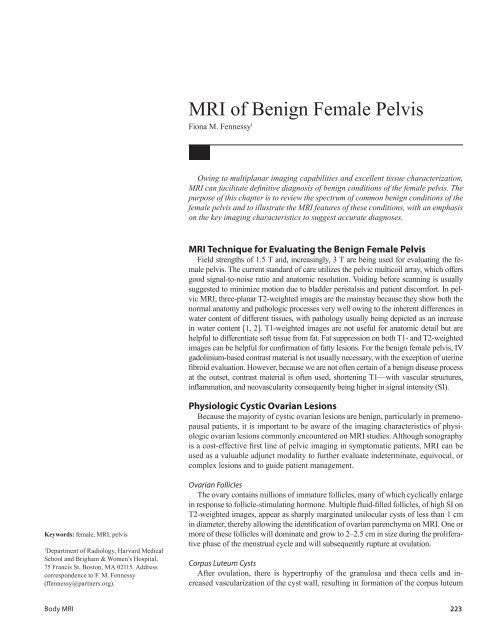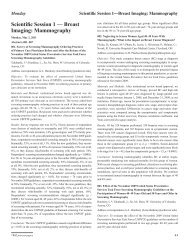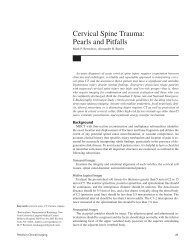Create successful ePaper yourself
Turn your PDF publications into a flip-book with our unique Google optimized e-Paper software.
Fennessyduring the secretory phase <strong>of</strong> the menstrual cycle. If the corpusluteum fails to regress, a corpus luteum cyst may form, usuallyat the end <strong>of</strong> the luteal phase or in pregnancy. These cystsusually have a thick, irregular, avidly enhancing wall on T1-weighted imaging after contrast administration, are single, andrange from 2.5 cm to 6 cm in size [3]. They may also containcomplex fluid SI owing to blood products formed at the time<strong>of</strong> ovulation.Follicular CystsOn occasion, a mature follicle will fail to ovulate and releasethe oocyte and will continue to enlarge into the nextmenstrual cycle. The typical appearance <strong>of</strong> these follicularcysts is a unilocular cyst <strong>of</strong> uniform high SI on T2-weightedimaging, which can sometimes (but only rarely) attain size <strong>of</strong>5 cm or more [4] (Fig. 1). These cysts have thin walls andsharply defined borders. The cyst wall may have a thin enhancingrim on contrast-enhanced <strong>MRI</strong>. A follow-up examinationafter one or two menstrual cycles should reveal involution<strong>of</strong> these follicular cysts.Hemorrhagic CystsAny time during the menstrual cycle when hemorrhageoccurs into either a follicular cyst or a corpus luteal cyst, ahemorrhagic cyst forms. Patients with hemorrhagic cystscommonly present with acute-onset abdominal pain. The<strong>MRI</strong> characteristics may vary depending on the stage <strong>of</strong> hemorrhageand clot retraction. Hemorrhagic cysts usually havehigh SI on T1-weighted images (Fig. 1). Because they usuallyresolve spontaneously, short-interval follow-up can be recommendedto confirm resolution and exclude pathologic entitiessuch as an endometrioma.<strong>Benign</strong> Ovarian Neoplasms<strong>Benign</strong> Germ Cell Neoplasm (Dermoid Cystor Mature Cystic Teratoma)The mature cystic teratoma (also known as a “dermoidcyst” or “dermoid”) is by far the most common germ cell tumorand is composed <strong>of</strong> at least two <strong>of</strong> the three germ celllayers (endoderm, mesoderm, and ectoderm). This is a commonbenign tumor in young women and is <strong>of</strong>ten incidentallydetected. Bilateral lesions are noted in approximately 20% <strong>of</strong>patients with these tumors. Because the cyst is usually linedwith ectoderm, it fills with desquamated keratin and sebaceoussecretions, with resultant SI similar to that <strong>of</strong> fat on all sequenceson <strong>MRI</strong> [5] (Fig. 2). The signal pattern <strong>of</strong> fat may besimilar to that <strong>of</strong> hemorrhage in endometrial cysts or hemorrhagicovarian cysts; thus, a fat-suppression <strong>MRI</strong> techniquecan be used to differentiate among these tumors [6]. In caseswhere the dermoid is predominantly cystic and contains onlyACBDFig. 1—Cystic ovarian lesions.A and B, Sagittal T1-weighted (A) andsagittal T2-weighted (B) images show large,simple well-defined lesion (asterisk) <strong>of</strong> fluidattenuation that is separate from uterus. Thisis a serous cystadenoma. A large follicular cystmay also be considered, but they rarely attainthis size, and usually resolve on follow-up.C and D, Axial T2-weighted (C) and T1-weighted fat-saturated (D) images after IVgadolinium administration show adnexallesion (arrow) <strong>of</strong> high signal intensity onT2-weighted imaging but which remains<strong>of</strong> high signal intensity on T1 fat-saturatedimages without enhancement, consistent withhemorrhagic cyst.224 2013 ARRS Categorical Course
<strong>MRI</strong> <strong>of</strong> <strong>Benign</strong> <strong>Female</strong> <strong>Pelvis</strong>ABCFig. 2—Ovarian dermoid.A–C, Sagittal T1-weighted (A), axial T1-weighted (B), and axial T1-weighted fat-saturated (C) images after IV gadolinium administration show mass(arrow) that is separate from uterus (U) and has signal intensity similar to fat on all sequences (i.e., high signal intensity on T1-weighted images and lowsignal intensity on T1-weighted fat-saturated images), consistent with ovarian dermoid.microscopic fat, chemical-shift (in phase and opposed phase)imaging may be useful [7]. <strong>MRI</strong> may also prove beneficial byrevealing complications <strong>of</strong> dermoids, such as rupture, whichmay be identified as sebaceous material <strong>of</strong> fat intensity floatingin the peritoneal cavity.<strong>Benign</strong> Sex Chord Stromal Tumor (OvarianFibroma or Thecoma)Ovarian fibromas are benign mesenchymal tumors <strong>of</strong> theovary, most commonly occurring in peri- or postmenopausalwomen. Because they are composed <strong>of</strong> fibroblasts and abundantcollagenous tissue, these tumors typically show SI similarto smooth muscle on <strong>MRI</strong>, are usually <strong>of</strong> low SI on T2- andT1-weighted images, and enhance to the same degree as muscleafter contrast administration (Fig. 3). Fibromas have an averagesize <strong>of</strong> 6 cm [8] but can grow much larger. Infrequently, ovarianfibromas, particularly when larger than 10 cm, can be associatedwith ascites and pleural effusion (Meigs syndrome), whichsubsequently resolve after resection <strong>of</strong> the fibroma. Sometimes,when the ipsilateral ovary is not readily apparent, these tumorscan be difficult to differentiate from an exophytic uterine fibroid.Ovarian fibroma should also be distinguished from ovarianfibromatosis. This is a rare benign condition that manifestsas bilateral ovarian masses that have a dominant fibrous component,showing low SI on T2-weighted images. However, inovarian fibromatosis, there are usually ovarian follicles apparentbetween the fibrous tissue and the lesions are bilateral [9].<strong>Benign</strong> Epithelial Ovarian NeoplasmEpithelial tumors account for at least 60% <strong>of</strong> all ovarianneoplasms. The most common are serous epithelial tumors,also known as “cystadenomas,” and <strong>of</strong> these, approximately60% are benign. Serous cystadenomas <strong>of</strong> the ovary commonlyappear as unilocular, thin-walled cysts filled with simplefluid, which are usually 5–10 cm in size but may be muchlarger (Fig. 1). The size <strong>of</strong> the lesion, in addition to the presence<strong>of</strong> papillary mural projections, best correlates with risks<strong>of</strong> malignancy and tumor aggressiveness. In general, smaller,simple-appearing cystic lesions are managed by observation,whereas those larger than 10 cm are thought to be at greaterrisk <strong>of</strong> malignancy and are removed.The second most common epithelial tumors are mucinousepithelial tumors, representing about 20–25% <strong>of</strong> ovarian tumors.Approximately 80% <strong>of</strong> these are benign. Mucinous cystadenomastypically show characteristic multilocular masseswith varying signal intensities in the locules (stained-glass appearance)on <strong>MRI</strong> (Fig. 4) and tend to be larger at presentationthan their serous counterparts, <strong>of</strong>ten around 20 cm at diagnosis[6]. Usually, the presence <strong>of</strong> thick septations suggests borderlinelesions, whereas the presence <strong>of</strong> more solid componentssuggests carcinoma.<strong>Benign</strong> Disease Processes Involvingthe <strong>Female</strong> <strong>Pelvis</strong>EndometriosisEndometriosis occurs when endometrial tissue implants outsidethe uterine cavity and responds to cyclic hormonal stimulation.In endometriosis, the most common implantation site isalong the serosal surface <strong>of</strong> the uterus and along the ovaries.It also has a predilection for scar tissue in women who havehad prior cesarean section or other uterine surgeries. However,endometrial deposits can involve any peritoneal surface withinBody <strong>MRI</strong> 225
<strong>MRI</strong> <strong>of</strong> <strong>Benign</strong> <strong>Female</strong> <strong>Pelvis</strong>Fig. 8—Uterine fibroid.A, Coronal T2-weighted image shows lesscommon, hypercellular uterine fibroid (F)<strong>of</strong> high signal intensity, surrounded by lowsignal-intensitymyometrium.B, Sagittal T2-weighted image shows hyalinedegeneration with speckled areas <strong>of</strong> low andhigh signal intensity.C and D, Coronal T1-weighted fat-saturatedimages before (C) and after (D) IV gadoliniumadministration show high signal intensity beforecontrast administration, consistent with bloodproducts, and lack <strong>of</strong> enhancement after contrastadministration, consistent with hemorrhagic(also known as red or carneous) degeneration.ABT2-weighted images (i.e., lower SI than is seen with usual fibroids)or a speckled pattern <strong>of</strong> low SI and high SI (Fig. 8).Findings indicating hemorrhagic degeneration may depend onthe time since degeneration, but usually hemorrhagic degenerationis seen as high SI on T1-weighted images within theentire fibroid and lack <strong>of</strong> enhancement after administration <strong>of</strong>contrast material (Fig. 8). Calcification along the periphery <strong>of</strong>the fibroid can occur and is best appreciated on gradient-echoT1-weighted images. A rare variation is the lipoleiomyoma,consisting <strong>of</strong> mature adipose tissue interspersed with smoothmuscle cells and fibrous tissue.Details <strong>of</strong> the variable imaging characteristics on <strong>MRI</strong> canalso play important roles in determining the optimal treatment.Because uterine artery embolization exerts its treatment effectthough the release <strong>of</strong> microparticles into the feeding vessels <strong>of</strong>the fibroid and <strong>MRI</strong>-guided focused ultrasound surgery causestemperature elevation in fibroid tissue with resultant celldeath, both <strong>of</strong> these treatment options require an intact bloodCDsupply to the fibroid before treatment. SI on T2-weighted imagingis also an important detail that may determine optimaltreatment; for example, it is usually easier to induce sufficienttemperature elevations in typical fibroids (i.e., those <strong>of</strong> low SIon T2-weighted images) through <strong>MRI</strong>-guided focused ultrasoundsurgery, and these have a better outcome than hypercellularfibroids.SummaryBecause <strong>of</strong> inherent tissue contrast, <strong>MRI</strong> <strong>of</strong>fers much informationon benign physiologic and pathologic processes in thefemale pelvis. Although <strong>of</strong>ten not the first line <strong>of</strong> imaging forbenign pelvic disease, <strong>MRI</strong> can facilitate definitive diagnosisonce key imaging characteristics <strong>of</strong> the physiologic or pathologicprocess are known.REFERENCES1. Troiano RN, Lange RC, McCarthy S. Conspicuity <strong>of</strong> normal and pathologic femalepelvic anatomy: comparison <strong>of</strong> gadolinium-enhanced T1-weighted images andBody <strong>MRI</strong> 229
Fennessyfast spin echo T2-weighted images. J Comput Assist Tomogr 1996; 20:871–8772. Lee JK, Gersell DJ, Balfe DM, Worthington JL, Picus D, Gapp G. The uterus: in vitroMR-anatomic correlation <strong>of</strong> normal and abnormal specimens. Radiology 1985;157:175–1793. [No authors listed]. <strong>Female</strong> reproductive system. In: Rosai J, ed. Ackerman’s surgicalpathology, 10th ed. St. Louis, MO: Mosby, 2011:1558–15594. Outwater EK, Mitchell DG. Normal ovaries and functional cysts: MR appearance.Radiology 1996; 198:397–4025. Outwater EK, Siegelman ES, Hunt JL. Ovarian teratomas: tumor types and imagingcharacteristics. RadioGraphics 2001; 21:475–4906. Pretorius ES, Outwater EK, Hunt JL, Siegelman ES. Magnetic resonance imaging<strong>of</strong> the ovary. Top Magn Reson Imaging 2001; 12:131–1467. Yamashita Y, Hatanaka Y, Torashima M, Takahashi M, Miyazaki K, Okamura H. Maturecystic teratomas <strong>of</strong> the ovary without fat in the cystic cavity: MR features in12 cases. AJR 1994; 163:613–6168. Young RH, Scully RE. Sex-cord stromal tumor, steroid cell, and other ovariantumors with endocrine, paraendocrine, and paraneoplastic manifestations. In:Kurman RJ, ed. Blaustein’s pathology <strong>of</strong> the female genital tract, 4th ed. New York,NY: Springer-Verlag, 1994:783–8479. Bazot M, Salem C, Cortez A, Antoine JM, Darai E. Imaging <strong>of</strong> ovarian fibromatosis.AJR 2003; 180:1288–129010. Vinatier D, Orazi G, Cosson M, Dufour P. Theories <strong>of</strong> endometriosis. Eur J ObstetGynecol Reprod Biol 2001; 96:21–3411. Parazzini F, Vercellini P, Panazza S, Chatenoud L, Oldani S, Crosignani PG. Riskfactors for adenomyosis. Hum Reprod 1997; 12:1275–127912. Bazot M, Cortez A, Darai E, et al. Ultrasonography compared with magnetic resonanceimaging for the diagnosis <strong>of</strong> adenomyosis: correlation with histopathology.Hum Reprod 2001; 16:2427–243313. Reinhold C, Atri M, Mehio A, Zakarian R, Aldis AE, Bret PM. Diffuse adenomyosis:comparison <strong>of</strong> endovaginal US and MR imaging with histopathologic correlation.Radiology 1995; 197:609–61414. Velebil P, Wingo PA, Xia X, Wilcox LS, Peterson HB. Rate <strong>of</strong> hospitalization forgynecologic disorders among reproductive-age women in the United States.Obstet Gynecol 1995; 86:764–76915. Baird DD, Dunson DB, Hill MC, Cousins D, Schectman JM. High cumulative incidence<strong>of</strong> uterine leiomyoma in black and white women: ultrasound evidence.Am J Obstet Gynecol 2003; 188:100–10716. Baird DD. Uterine leiomyomata: we know so little but could learn so much. Am JEpidemiol 2004; 159:124–12617. Fennessy F, Tempany C. Focused ultrasound ablation <strong>of</strong> uterine leiomyomas. In:Fielding J, Brown D, Thurmond A, eds. Gynecologic imaging. Philadelphia, PA: W.B. Saunders, 2011:584–589230 2013 ARRS Categorical Course
















